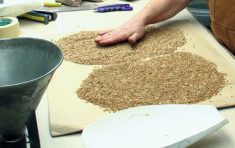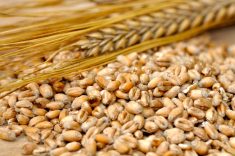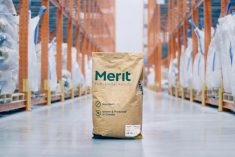The Canadian Grain Commission (CGC), whose role in Canadian grain quality assurance is under federal review, wants to cut its fees for four official grain inspection and official grain weighing services effective Aug. 1, the start of the new crop year.
The change will save Canada’s grain sector millions of dollars over the next three years, CGC chief commissioner Doug Chorney said in a release Thursday.
“We are lowering (CGC) service fees early in response to the growth in grain export volumes,” he said.
The CGC wants to cut its $1.48 a tonne fee for official inspection and weighing services (outward inspection) on ships by 29 per cent, to $1.05 a tonne.
Read Also

Dryness poised to threaten Saskatchewan crops
Crops in Saskatchewan are developing in opposite directions, the province’s latest crop report said. Growing conditions in the province vary, with some areas receiving enough rain while other locations are experiencing crop stress due to hot, dry conditions.
The CGC also wants a cost decrease of $37.88 per official inspection and weighing services for a railway car, truck, or container.
“For fiscal year 2021-22 (April 1, 2021-March 31, 2022), fees paid by grain sector stakeholders would be reduced by approximately $13.79 million, a cost decrease of 19 per cent,” the CGC said in its release.
“Savings for the 2022-23 and 2023-24 fiscal years are expected to be approximately $20.68 million each year, a cost decrease of 29 per cent.”
Why it matters: About 90 per cent of the Canadian Grain Commission’s $65 million annual budget comes from fees collected from grain companies for mandatory services such as outward inspection. While CGC inspection fees are paid by grain companies, it’s agreed most of the cost is passed on to farmers.
While the fee cuts are expected to come, the proposed changes require amendment to the Canada Grain Regulations. They are expected to be published in the Canada Gazette, Part I for public comment on Saturday and stakeholders have until June 7 to provide feedback.
A number of farm groups called for lower CGC fees in recent submissions to Agriculture and Agri-Food Canada, which is reviewing the Canada Grain Act and the CGC, which administers it.
But CGC chief commissioner Doug Chorney says the move to adjust CGC fees two years early was not triggered by the review.
“We realize this might look like we’re posturing for the review process but that’s not the case at all really,” Chorney said in an interview Thursday.
“It’s a reflection of the fact that the surplus (in fee revenue) has continued to accumulate. Grain volumes have not just been up a bit they’re record breaking and it’s necessary for the fees to be adjusted to better reflect the actual grain volumes that are moving so that we’re not collecting more money than we need to provide our service.”
Most CGC fees are based on the amount of grain inspected and exported from Canada.
The baseline for existing service and licence fees was established in 2017-18 for the five-year period ending March 31, 2023. It was based on an annual average official inspection and weighing volume of 34.405 million tonnes, the CGC said Thursday.
The updated grain volume forecast for the next three years is 40 per cent higher, at 48.1 million tonnes.
“We did the same thing in 2017 when we were newly appointed commissioners and the fees were reviewed early and adjusted (lower),” Chorney said. “We try to be pragmatic in talking in the information that we were provided and being nimble and flexible to make sure that we are doing what is relevant.
“As with grain commissions in the past we use the best information available to come up with an approach. We think it’s the right thing to do at the right time.”
Because grain production can vary, so too can CGC fee revenue. But the CGC has a $40 million contingency fund it can access should its revenues fall.
However, the CGC has been criticized by some farm groups for a huge surplus that has built up since 2013 when the federal government resumed a former policy to make the CGC mostly self-sufficient, which saw the CGC raise its fees.
Despite several fee cuts since then, as of December 2020, the CGC estimated it would have a surplus of $146 million as of March 31.
“Today’s news (proposing reduced CGC fees) underscores that the current funding system, based on mandatory inspection services by the CGC, is fundamentally flawed and should be a priority to change as part of the Canada Grain Act review,” the Alberta Wheat and Barley Commissions (AWBC) said in a separate release Thursday.
“The CGC has accumulated a $148 million surplus, which will continue to grow due to the large volume of grain being moved in the current crop year. The CGC needs to adjust their funding model to expect variation and adopt a model that will allow excess funds to be returned to farmers through reduced operating fees.”
Both commissions want mandatory CGC outward inspection — the CGC’s major form of revenue — eliminated so grain companies can use cheaper private company inspectors.
The Western Grain Elevator Association (WGEA), which represents Canada’s major grain companies, wants the same, noting private inspectors already inspect 70 per cent of Canadian grain exported by ship. It and the AWBC argue double inspection costs ultimately come out of farmers’ pockets.
Both say Canadian grain quality can be protected if the CGC certifies and monitors private inspectors.
However, farm groups including the Agricultural Producers Association of Saskatchewan (APAS), the Saskatchewan Barley Development Commission, the Saskatchewan Wheat Development Commission (Sask Wheat), Keystone Agricultural Producers and National Farmers Union say they want mandatory CGC outward inspection to remain to protect Canada’s grain quality reputation.
Both APAS and Sask Wheat welcomed the CGC’s plan to cut fees.
“We have been calling for more transparency in the system and are happy the commission has responded to those requests,” APAS president Todd Lewis said in a release Thursday.
“These savings will allow producers to invest more in their operations and we thank (Agriculture) Minister (Marie-Claude) Bibeau for reducing fees on this essential service for our producers. This fee reduction is the result of good work by chief commissioner (Doug) Chorney and the staff at the CGC.”
The fee reduction makes sense because of growing Canadian grain exports, Sask Wheat said in a separate release.
“Ensuring the fee setting process accurately reflects inspection and weighing volumes is crucial to prevent producers from being overcharged,” Sask Wheat chair Brett Halstead said.
In its grain act review submission Sask Wheat called for an immediate review of CGC user fees and the fee-setting system to ensure CGC surpluses don’t continue to grow.
Sask Wheat also wants the federal government to cover CGC operating costs seen as a public benefit.
— Allan Dawson is a reporter for the Manitoba Co-operator at Miami, Man.















